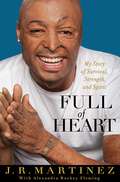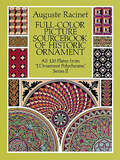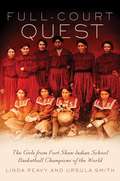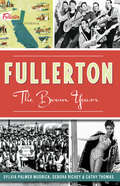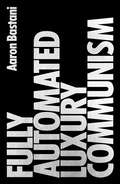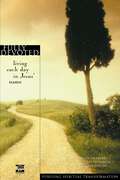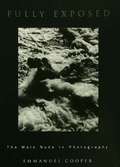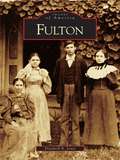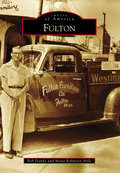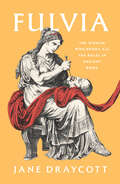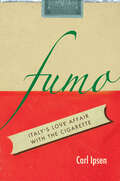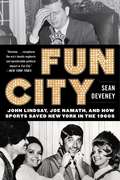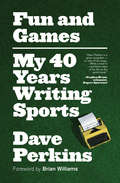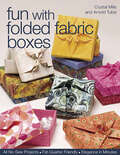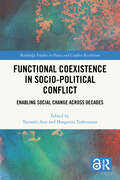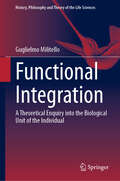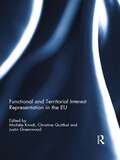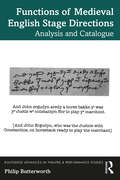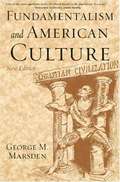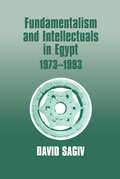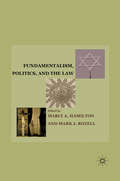- Table View
- List View
Full of Beans
by Jennifer L. HolmNewbery Honor Book Turtle in Paradise is beloved by readers, and now they can return to this wonderful world through the eyes of Turtle's cousin Beans. <P><P>Grown-ups lie. That's one truth Beans knows for sure. He and his gang know how to spot a whopper a mile away, because they are the savviest bunch of barefoot conchs (that means "locals") in all of Key West. Not that Beans really minds; it's 1934, the middle of the Great Depression. <P>With no jobs on the island, and no money anywhere, who can really blame the grown-ups for telling a few tales? <P>Besides, Beans isn't anyone's fool. In fact, he has plans. Big plans. And the consequences might surprise even Beans himself. <P><b> Winner of the Scott O'Dell Award for Historical Fiction </b>
Full of Heart: My Story of Survival, Strength, and Spirit
by J. R. Martinez Alexandra Rockey FlemingAn inspirational journey from tragedy to triumph In 2003, nineteen-year-old Private J. R. Martinez was on a routine patrol when the Humvee he was driving hit an antitank mine in Iraq, resulting in severe injuries and burns on his face and more than one-third of his body. Out of that tragedy came an improbable journey of inspiration, motivation, and dreams come true. In Full of Heart, Martinez shares his story in intimate detail, from his upbringing in the American South and his time in the Army to his recovery and the indomitable spirit that has made him an inspiration to countless fans. J. R. Martinez always had a strong spirit. Raised in Bossier City, Louisiana, and then Hope, Arkansas, by a single mother from El Salvador, he was well known at school for his good looks and his smart mouth. At seventeen, showing an early determination and drive that would become one of his trademark qualities, J. R. convinced his mom to move to Dalton, Georgia, where he believed he would have a better chance of being recruited to play college football. His positive attitude earned him a spot on a competitive high school football squad, but when his college dreams collapsed, he turned to the U. S. Army. A few months later, he found himself serving in Iraq. When J. R. 's humvee hit a mine and exploded--just one month into his deployment--he was immediately evacuated to a San Antonio medical center, where he spent the next thirty-four months in grueling recovery. Seeing his disfigured face for the first time after the accident threw him into a crushing period of confusion and anger. His spirits were low, until he was asked to speak to another young burn victim. J. R. realized how valuable and gratifying it was to share his experiences with other patients and listen to theirs. He'd found a calling. His fellow soldiers, along with the local and then national media, soon latched onto J. R. 's spirit and strength. His resilience, optimism, and charm were also noted by Hollywood and scored him roles on All My Children and Dancing with the Stars, where he was the season thirteen champion. Today, J. R. tours the country sharing his story and his lessons for overcoming challenges and embracing hope, lessons that abound in this book. Full of Heart is an unforgettable story of a man who never gave up on his dreams. After being injured in Iraq, J. R. Martinez became a motivational speaker, actor, and winner of season thirteen of Dancing with the Stars. Martinez lives in Los Angeles
Full-Color Picture Sourcebook of Historic Ornament: All 120 Plates from "L'Ornement Polychrome," Series II (Dover Fine Art, History of Art)
by Auguste RacinetClassic sourcebook of spectacular royalty-free design collages, featuring over 1,500 decorative elements and motifs from major cultures in history through the 19th century, from Asia and Africa to Europe and the Americas. Adapted from jewelry, illuminated manuscripts, weapons, tiles, carved wood panels, ceilings, inlay, hardware, ceramics and more.
Full-Court Quest: The Girls From Fort Shaw Indian School Basketball Champions of the World
by Ursula Smith Linda PeavyMost fans of women's basketball would be startled to learn that girls' teams were making their mark more than a century ago--and that none was more prominent than a team from an isolated Indian boarding school in Montana. Playing like "lambent flames" across the polished floors of dance halls, armories, and gymnasiums, the girls from Fort Shaw stormed the state to emerge as Montana's first basketball champions. Taking their game to the 1904 St. Louis World's Fair, these young women introduced an international audience to the fledgling game and returned home with a trophy declaring them champions. World champions. And yet their triumphs were forgotten--until Linda Peavy and Ursula Smith chanced upon a team photo and embarked on a ten-year journey of discovery. Their in-depth research and extensive collaboration with the teammates' descendents and tribal kin have resulted in a narrative as entertaining as it is authentic. Full-Court Quest offers a rare glimpse into American Indian life and into the world of women's basketball before "girls' rules" temporarily shackled the sport.
Fullerton: The Boom Years
by Cathy Thomas Sylvia Palmer Mudrick Debora RicheyAmerica enjoyed newfound prosperity in the decades following World War II, and Southern California was an epicenter of postwar growth. Among the many Orange County communities that grew and flourished in this hopeful and exciting era, Fullerton led the way. Join authors Sylvia Palmer Mudrick, Debora Richey and Cathy Thomas as they recount Fullerton's boom years. It was a time characterized by economic growth, vibrant development and engaged civic participation. From the founding of the world-famous Fender guitar company to the establishment of Fullerton's first university, discover the events and people that transformed Fullerton from a small town to a thriving city.
Fully Automated Luxury Communism
by Aaron BastaniA different kind of politics for a new kind of society--beyond work, scarcity and capitalismIn the twenty-first century, new technologies should liberate us from work. Automation, rather than undermining an economy built on full employment, is instead the path to a world of liberty, luxury and happiness—for everyone. Technological advance will reduce the value of commodities—food, healthcare and housing—towards zero. Improvements in renewable energies will make fossil fuels a thing of the past. Asteroids will be mined for essential minerals. Genetic editing and synthetic biology will prolong life, virtually eliminate disease and provide meat without animals. New horizons beckon. In Fully Automated Luxury Communism, Aaron Bastani conjures a vision of extraordinary hope, showing how we move to energy abundance, feed a world of 9 billion, overcome work, transcend the limits of biology, and establish meaningful freedom for everyone. Rather than a final destination, such a society merely heralds the real beginning of history.
Fully Devoted: Living Each Day in Jesus' Name (Pursuing Spiritual Transformation)
by John Ortberg Laurie Pederson Judson PolingWhat does it mean to do everything "in Jesus’ name"? Is that an ideal attainable only by a few "super Christians"--or is it a way of life we can all experience?Leader’s guide included!Fully Devoted group sessions are:What Is True Spirituality?GraceGrowthGroupsGiftsGiving"We Know Him Well . . . "
Fully Exposed: The Male Nude in Photography
by Emmanuel CooperFully Exposed is a pioneering cultural history of the photography of the male nude which sets the photographer and the model within our cultural and historical perceptions and prejudices. This second edition extends the book's coverage so that the story from the beginnings of the medium to the present day is complete.Fully Exposed is lavishly illustrated with over two hundred and fifty photographs,many of them new to this edition. Different chapters discuss how the male nude has been used by artists, the way it has been treated in the popular press,in relation to British colonialism and scientific ideology. It also discusses `private pictures' taken at home or acquired as erotic material by the private collector. A final chapter brings the book up-to-date and discusses the male nude in the nineties.The combination of art criticism and photographic essay make this an unusual and important book both for academics and the general reader.
Fulton
by Elizabeth R. JonesLocated in the southwestern part of the state, Fulton, Kentucky was first known as Pontotoc by the native Chickasaw Indians. The town was founded in 1828, along with its sister city, South Fulton, Tennessee, when Benjamin Franklin Carr purchased 160 acres from the Commonwealth of Kentucky. The town was labeled the "end of the line" by the federal government due to its pivotal position at the termination point of the Paducah-Memphis rail-all mail sent to the region was addressed as such. Images of America: Fulton follows the agricultural and industrial development of the region, and provides local folklore as well.
Fulton (Images of America)
by Bob Franks Mona Robinson MillsFulton is one of the oldest cities in northern Mississippi. Established on May 11, 1837, by an act of the Mississippi legislature, the city is the northernmost town on the Tombigbee River, located less than 10 miles south of that river’s headwaters. Fulton was settled by hardy pioneers seeking new opportunities in the newly available lands of Mississippi’s Chickasaw Cession. From its first days, Fulton was the center of commercial activity in Itawamba County, as well as the home to county government. During the Civil War and Reconstruction, the town declined, until a period of new growth and activity took place during the early 20th century. At that time, the timber industry became a lucrative venture, and the Mississippian Railway was established, connecting Fulton to the Frisco Railroad in Amory, 20 miles to the south. Fulton is now home to Itawamba Community College and is adjacent to the Tennessee-Tombigbee Waterway, one of the largest inland waterways in the nation.
Fulvia: The Woman Who Broke All the Rules in Ancient Rome
by Jane DraycottJane Draycott reclaims the life story of Fulvia, one of the most powerful women of the late Roman Republic &“Light and thorough, wide-reaching and focused, entertaining but not sensationalist.&”—Financial Times Fulvia was born into wealth, privilege, and prestige around the year 80 BCE, yet there was nothing inherently special about her—she was not a saint, an empress, or a queen. But during the years leading up to the fall of the Roman Republic, Fulvia was moving in the most powerful social circles, and by her death in 40 BCE she had amassed a degree of political and military power unprecedented for a woman. Fulvia&’s success came at considerable cost, however. None of her three marriages to politically powerful men—most famously to Marc Antony—lasted, and three of her five children died violently. She was repeatedly ridiculed for daring to step outside the confines of the domestic sphere. The deliberate and systematic destruction of her reputation shaped her legacy for two millennia. Ample literary, documentary, and archaeological sources for Fulvia exist, yet most contemporary depictions of her were extremely negative. Historian Jane Draycott, reading between the lines of the ancient evidence, proposes a more nuanced interpretation. Using Fulvia as a guide, she invites readers to visit an unfamiliar Rome, one in which women played a crucial role during Rome&’s violent transition from a republic to the dictatorship of the Roman Empire.
Fumiko and a Tokyo Tragedy: A Great Kanto Earthquake Survival Story (Girls Survive)
by Susan Griner12-year-old Fumiko is fascinated by the Moga girls, modern young women with short hair and casual dresses who are making their way in 1920s Tokyo. Her parents, however, expect a traditional life for her. But none of that matters when the Great Kanto Earthquake strikes the city on September 1, 1923. Can Fumiko withstand the fires and confusion that follow the shaking earth, and how will the tragedy change her future? Readers can learn the real story of the Great Kanto Earthquake from the nonfiction back matter in this Girls Survive story. A glossary, discussion questions, and writing prompts are also provided.
Fumo: Italy's Love Affair with the Cigarette
by Carl David IpsenFor over a century, Italy has had a love affair with the cigarette. Perhaps no consumer item better symbolizes the economic, political, social, and cultural dimensions of contemporary Italian history. Starting around 1900, the new and popular cigarette spread down the social hierarchy and eventually, during the 1960s, across the gender divide. For much of the century, cigarette consumption was an index of economic well-being and of modernism. Only at the end of the century did its meaning change as Italy achieved economic parity with other Western powers and entered into the antismoking era. Drawing on film, literature, and the popular press, Carl Ipsen offers a view of the "cigarette century" in Italy, from the 1870s to the ban on public smoking in 2005. He traces important links between smoking and imperialism, world wars, Fascism, and the protest movements of the 1970s. In considering this grand survey of the cigarette, Fumo tells a much larger story about the socio-economic history of a society known for its casual attitude toward risk and a penchant for la dolce vita.
Fun City: John Lindsay, Joe Namath, and How Sports Saved New York in the 1960s
by Sean DeveneyOn January 1, 1966, New York came to a standstill as the city’s transit workers went on strike. This was the first day on the job for Mayor John Lindsay--a handsome, young former congressman with presidential aspirations--and he would approach the issue with an unconventional outlook that would be his hallmark. He ignored the cold and walked four miles, famously declaring, "I still think it is a fun city. ” As profound social, racial, and cultural change sank the city into repeated crises, critics lampooned Lindsay’s "fun city. ” Yet for all the hard times the city endured during and after his tenure as mayor, there was indeed fun to be had. Against this backdrop, too, the sporting scene saw tremendous upheaval. On one hand, the venerable Yankees--who had won 15 pennants in an 18-year span before 1965--and the NFL’s powerhouse Giants suddenly went into a level of decline neither had known for generations, as stars like Mickey Mantle and Whitey Ford on the diamond and Y. A. Tittle on the gridiron aged quickly. But on the other, the fall of the city’s sports behemoths was accompanied by the rise of anti-establishment outsiders--there were Joe Namath and the Jets, as well as the shocking triumph of the Amazin’ Mets, who won the 1969 World Series after spending the franchise’s first eight seasons in the cellar. Meanwhile, the city’s two overlooked franchises, the Knicks and Rangers, also had breakthroughs, bringing new life to Madison Square Garden. The overlap of these two worlds in the 1960s--Lindsay’s politics and the reemerging sports landscape--serves as the backbone of Fun City. In the vein of Ladies and Gentlemen: The Bronx is Burning, the book tells the story of a remarkable and thrilling time in New York sports against the backdrop of a remarkable and often difficult time for the city, culturally and socially. The late sixties was an era in which New York toughened up in a lot of ways; it also was an era in which a changing of the guard among New York pro teams led the way in making it a truly fun city.
Fun Home
by Alison Bechdel Jeanine Tesori Lisa KronWhen her father dies unexpectedly, graphic novelist Alison dives deep into her past to tell the story of the volatile, brilliant, one-of-a-kind man whose temperament and secrets defined her family and her life. Moving between past and present, Alison relives her unique childhood playing at the family's Bechdel Funeral Home, her growing understanding of her own sexuality, and the looming, unanswerable questions about her father's hidden desires. Fun Home is a refreshingly honest, wholly original musical about seeing your parents through grown-up eyes.
Fun and Games: My 40 Years Writing Sports
by Dave Perkins&“Covering many of the biggest names and greatest events in sports, it&’s a wonderful collection of yarns and reminiscences, told in Perk&’s inimitable style&” (Postmedia News). Dave Perkins was once told by a bluntly helpful university admissions officer: &“You don&’t have the looks for TV or the voice for radio. You should go into print.&” Which he did, first at the Globe and Mail, and then for thirty-six well-traveled years at the Toronto Star. In Fun and Games, Perkins recounts hysterical, revealing, and sometimes embarrassing personal stories from almost every sport and many major championships. After forty years of encountering a myriad of athletes, fans, team managers, and owners, Perkins offers unique observations on the Blue Jays and Raptors, fifty-eight major championships&’ worth of golf, ten Olympic Games, football, hockey, boxing, horse racing, and more. Learn why Tiger Woods asked Perkins if he was nuts, why he detected Forrest Gump in the 1996 Atlanta Olympics, and why Super Bowl week is the worst week of the year. Perkins exposes the mistakes he made in both thought and word—once, when intending to type &“the shot ran down the goalie&’s leg,&” he used an &“i&” instead of an &“o&”—and to this day, he has never found a sacred cow that didn&’t deserve a barbecue. &“Few can spin a yarn with the wit and clever turns of phrase that Perky can.&” —Shi Davidi, Sportsnet &“Anyone who has ever spoken to Dave Perkins, or read Dave Perkins, remembers his voice. This book is a delightful way to experience it all again, through the wise, funny man&’s eyes.&” —Bruce Arthur, Toronto Star sports columnist
Fun with Folded Fabric Boxes: All No-Sew Projects, Fat-Quarter Friendly, Elegance in Minutes
by Crystal Mills Arnold TubisA Bounty of Boxes to Fashion From Fabric & Paper. Quick and easy no-sew techniques for making beautiful origami boxes with our easy-to-follow how-to illustrations and photos. Make in a variety of sizes-and have fun embellishing them! There is no limit to the ways you can use these impressive boxes: pretty storage, home decor accents, gift boxes, party favors...Inspired by a traditional folded Japanese box (masu), the boxes can be funky, lavish, or elegant depending on the materials you choose. Perfect for fat quarters or those special papers you've been saving. Includes lots of embellishment ideas.
Function and Fantasy: Iron Architecture In The Long Nineteenth Century
by Paul Dobraszczyk Peter SealyThe introduction of iron – and later steel – construction and decoration transformed architecture in the nineteenth century. While the structural employment of iron has been a frequent subject of study, this book re-directs scholarly scrutiny on its place in the aesthetics of architecture in the long nineteenth century. Together, its eleven unique and original chapters chart – for the first time – the global reach of iron’s architectural reception, from the first debates on how iron could be incorporated into architecture’s traditional aesthetics to the modernist cleaving of its structural and ornamental roles. The book is divided into three sections. Formations considers the rising tension between the desire to translate traditional architectural motifs into iron and the nascent feeling that iron buildings were themselves creating an entirely new field of aesthetic expression. Exchanges charts the commercial and cultural interactions that took place between British iron foundries and clients in far-flung locations such as Argentina, Jamaica, Nigeria and Australia. Expressing colonial control as well as local agency, iron buildings struck a balance between pre-fabricated functionalism and a desire to convey beauty, value and often exoticism through ornament. Transformations looks at the place of the aesthetics of iron architecture in the late nineteenth and early twentieth centuries, a period in which iron ornament sought to harmonize wide social ambitions while offering the tantalizing possibility that iron architecture as a whole could transform the fundamental meanings of ornament. Taken together, these chapters call for a re-evaluation of modernism’s supposedly rationalist interest in nineteenth-century iron structures, one that has potentially radical implications for the recent ornamental turn in contemporary architecture.
Functional Coexistence in Socio-Political Conflict: Enabling Social Change Across Decades (Routledge Studies in Peace and Conflict Resolution)
by Tatsushi Arai Margarita TadevosyanThis book introduces the concept of functional coexistence as a context for building practical strategies for long-term conflict intervention and social change.Functional coexistence is a pragmatic relationship of mutual non-recognition sustained in the absence of physical violence. In this volume, a team of internationally recognized scholar-practitioners of peacebuilding presents seven in-depth case studies of functional coexistence, expanding its potential for practical conflict intervention. Bridging theory to evidence and vision to practice, the book offers guideposts for sustained conflict intervention, presents compelling examples of peace potential within the context of functional coexistence, and identifies common pathways for change among them. It also proposes a customized framework for program evaluation and highlights the merit of long-term policymaking and funding. Instead of losing hope based on traditional expectations of conflict resolution and reconciliation, this pioneering study of conflict non-resolution demonstrates the power of tenacious pragmatism, strategically guided by a decades-long historical view of social change.This book will be of interest to students of conflict resolution, peacebuilding, international relations, foreign policy, and security studies.The Open Access version of this book, available at http://www.taylorfrancis.com, has been made available under a Creative Commons Attribution-Non Commercial-No Derivatives (CC-BY-NC-ND) 4.0 license.
Functional Integration: A Theoretical Enquiry into the Biological Unit of the Individual (History, Philosophy and Theory of the Life Sciences #38)
by Guglielmo MilitelloThis book explores the main biological dimensions underlying functional integration and examines how they contribute to defining a biological individual as both a physiological and evolutionary unit. Functional integration lies at the heart of most definitions of both organisms and biological individuals, making it explanatorily relevant to biology as well as to the philosophy of biology. However, the notion—typically referring to any causal interdependence among biological functions—remains broad and lacks a coherent theoretical framework. This work addresses that gap by focusing on functional integration at the cellular level, which presents both a minimal degree of complexity (relative to multicellular organisms) and maximal conceptual significance for this inquiry. By analysing the transition from prokaryotes to eukaryotes, the book sheds light on how spatial constraints, system-level regulatory mechanisms, spatio-temporal coordination, and system-level reproduction contribute to characterizing biological organization as a functionally integrated physiological unit. This study opens the way for a fresh reflection on the foundations of biological individuality, offering insights not only for researchers, but also for students and non-specialist readers.
Functional and Territorial Interest Representation in the EU (Journal Of European Integration Special Issues Ser.)
by Justin Greenwood Christine Quittkat MichDespite a substantial legacy of literature on EU interest representation, there is no systematic analysis available on whether a European model of interest representation in EU governance is detectable across functional, and territorial, categories of actors. ‘Functional’ actors include associations for business interests, the professions, and trade unions, as well as ‘NGOs’ and social movements; territorial based entities include public actors (such as regional and local government), as well as actors primarily organised at territorial level. What are the similarities and differences between territorial, and functional, based entities, and are the similarities greater than the differences? Are the differences sufficient to justify the use of different analytical tools? Are the differences within these categories more significant than those across them? Is there a ‘professionalised European lobbying class’ across all actor types? Does national embeddedness make a difference? Which factors explain the success of actors to participate in European governance? This book was originally published as special issue of Journal of European Integration.
Functions of Medieval English Stage Directions: Analysis and Catalogue (Routledge Advances in Theatre & Performance Studies)
by Philip ButterworthWhen we speak of theatre, we think we know what a stage direction is: we tend to think of it as an authorial requirement, devised to be complementary to the spoken text and directed at those who put on a play as to what, when, where, how or why a moment, action or its staging should be completed. This is the general understanding to condition a theatrical convention known as the 'stage direction'. As such, we recognise that the stage direction is directed towards actors, directors, designers, and any others who have a part to play in the practical realisation of the play. And perhaps we think that this has always been the case. However, the term 'stage direction' is not a medieval one, nor does an English medieval equivalent term exist to codify the functions contained in extraneous manuscript notes, requirements, directions or records. The medieval English stage direction does not generally function in this way: it mainly exists as an observed record of earlier performance. There are examples of other functions, but even they are not directed at players or those involved in creating performance. More than 2000 stage directions from 40 or so plays and cycles have been included in the catalogue of the volume, and over 400 of those have been selected for analysis throughout the work. The purpose of this research is to examine the theatrical functions of medieval English stage directions as records of earlier performance. Examples of such functions are largely taken from outdoor scriptural plays. This book will be of great interest to students and scholars in theatre, medieval history and literature.
Fundamentalism and American Culture (2nd edition)
by George M. MarsdenMany Americans today are taking note of the strong political force that is the religious right. Controversial decisions by the government are met with hundreds of lobbyists, millions of dollars of advertising spending, and a grassroots response.
Fundamentalism and Intellectuals in Egypt, 1973-1993
by David SagivThis study examines the attitude of Egyptian intellectuals towards Islamic fundamentalism in Egypt. They believe that to establish an Islamic state would mean a return to the Middle Ages and that Western values do not necessarily contradict Islam. How far can they influence Egypt's future?
Fundamentalism, Politics, and the Law
by Marci A. Hamilton Mark J. RozellThis book studies the phenomenon of fundamentalism in the United States. It contains historical and contemporary scholarly analysis of the Christian movements that emerged around the time of the Moral Majority.

